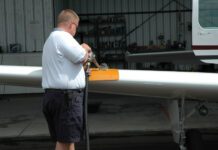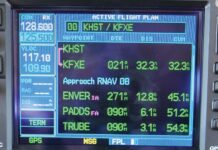Some recent fatal accidents have highlighted that general aviation pilots sometimes forget where they are and simply presume they have the performance and terrain clearance to motor off toward their destination after takeoff. That’s a result of complacency in the cockpit, aided and abetted by ATC giving us vectors when departing airports served by a local radar-equipped facility. That complacency means we often fail to follow published departure procedures when they’re not part of our clearance. Even in visual conditions, we can fail to properly consider our airplane’s inability to outclimb surrounding terrain. At night or in IMC, we won’t be able to see what hit us before it’s too late.
The thing is, an Obstacle Departure Procedure (ODP) isn’t always listed as such on your EFB. Sometimes it’ll come up as takeoff minimums, which Part 91 operators can ignore. Finding the actual ODP can require digging around unfamiliar references for text-only descriptions. Some ODPs may require climbing VFR over the airport before proceeding on what passes for a departure routing. When the weather doesn’t cooperate, you’re grounded. Much of this is well-hidden from pilots who don’t make the extra effort to research it.

According to the Aeronautical Information Manual (AIM, Para. 5-2-9) a visual climb over airport (VCOA) procedure is an option for a published obstacle departure procedure (ODP). VCOA procedures avoid obstacles greater than three sm from the departure end of the runway as an alternative to complying with climb gradients greater than 200 feet per nm. There are some requirements:
- Visual conditions equal to or greater than specified over the airport reaching the published “at or above” altitude.
- Pilots are to advise ATC as early as possible of their intent to fly the VCOA option prior to departure.
- Pilots are expected to remain within the distance prescribed in the published visibility minimums during the climb over the airport.
- The pilot must comply with any additional routing beyond when the “at-or-above” altitude is reached, which may include a climb-in-holding pattern to reach the MEA/MIA.
- If no additional routing is published, then the pilot may proceed in accordance with their IFR clearance.
Depending on the published ODP itself, on reaching the “at or above” altitude, there may be additional routing requirements or the pilot may proceed in IMC to the first en route fix using a diverse departure.
These are textual procedures published in the Take-Off Minimums and (Obstacle) Departure Procedures section of the Terminal Procedures Publications and/or appear as an option on a graphic ODP.
BEECH G36,BONANZA, KASE
On July 3, 2021, a Beech G36 Bonanza “was destroyed at about 1838 Mountain time when it collided with terrain. The two pilots aboard were fatally injured. Visual conditions prevailed.” So began our preliminary coverage of this accident in September 2021’s Accident Briefs. Our narrative omitted commentary and any speculation on what was going on.
As we wrote at the time, “Prior to takeoff, the pilots rejected an IFR clearance requiring a climb to 17,000 feet, opting instead to climb VFR over the airport and proceed ‘once we see what’s going on.’ As the flight climbed through 10,100 feet, the pilots informed the tower that they would depart to the east, stating ‘we’re above it,’ and the controller approved a frequency change. The flight continued to the east and southeast and soon approached a ridgeline topping out at over 13,000 feet. Tracking data indicated the airplane was at 11,500 feet msl as it approached the ridgeline, then it dropped off radar.”
Flying IFR in or out of Aspen isn’t for the faint of heart, even if you’re riding turbine equipment with climb rate and performance to spare. In a normally aspirated Bonanza, it’s a completely different and more challenging operation, as these two pilots realized on the ground. Their initial clearance was via the LINDZ9 departure procedure, which is excerpted in the sidebar above. The pair was told to maintain 16,000 feet msl and to expect 17,000 10 minutes after departure, none of which a normally aspirated Bonanza can do in a hurry. That’s the clearance the crew rejected, preferring instead to climb in visual conditions over the airport.
Importantly, there is a published ODP at Aspen, the SARDD Three graphic ODP. It requires climbing to 16,000 before reaching LINDZ or climbing in a hold at LINDZ, before proceeding on course. The record doesn’t say whether the crew knew of this option, but it’s not likely they would have chosen it, as the altitude requirement is the same as the original, rejected clearance.
As they climbed out of 10,100 feet, they decided they could turn on course and proceed to the east. The sidebar above details the original clearance and depicts how far from Aspen the plane got before colliding with terrain. They made it 10 nm.
This accident occurred during daylight, in visual conditions. Yet its root causes involve failure—rejection, actually—to follow a published departure procedure.
BEECH S35 BONANZA, KRHP

Ultimately, there’s more going on in this accident than failing to follow an IFR departure procedure. High density altitude and unfamiliar terrain are part of it. So is failure to adopt some basic mountain-flying techniques and possibly even failure to properly lean the engine for maximum power at altitude. Ultimately, this is a classic controlled flight into terrain (CFIT) accident.
The AOPA Air Safety Institute produced a video about this accident, which can be viewed for free at: youtube.com/watch?v=8PBUVMCbmFQ.
At this writing, the NTSB’s investigation into this accident is not complete and the Board has not issued a probable cause statement.
In our January 2021 Accident Briefs, we wrote about the October 3, 2021, crash of a V-tail Bonanza as it departed Andrews, N.C.: “The airplane was destroyed at about 1948 Eastern time when it apparently flew into terrain under control. The private pilot and the passenger were fatally injured. Although the departure airport was VFR in rain, it’s likely the accident site was experiencing night instrument conditions.
“The pilot purchased the airplane in June 2021. He departed Liberty, Texas, with a likely ultimate destination of Lancaster, Penn. The pilot’s arrival at a presumed fuel stop in North Carolina included a go-around and making left traffic to a runway with a published righthand pattern. The pilot added 60 gallons of fuel, received a preflight briefing from Leidos and filed an IFR flight plan.
“Weather at the departure airport included scattered clouds at 1400 feet, broken clouds at 3200 feet and seven miles of visibility in rain. Preliminary ADS-B data indicate the flight departed Runway 08 and made a slight left turn toward the northeast. The last recorded data point showed the airplane at about 3750 feet msl in a 656-fpm climb at 98 knots, on a course of 042 degrees. The last ADS-B data point was about 500 feet laterally from the initial impact with pine trees at an approximate elevation of 3950 feet. Examination revealed the wing flaps were retracted; the landing gear was extended.

“Takeoff minimums and procedures for the departure airport require remaining within three nm while climbing in visual conditions to cross the airport westbound at or above 4900 feet msl, then a climb to 7000 feet on a westerly heading to a Vortac radial, and then to the Vortac, before proceeding on course. The procedure is not authorized at night.
“According to a witness, the pilot had recently transitioned from a Piper Warrior equipped with fixed landing gear. Sunset was about 1917 and the end of civil twilight was 1941.”
As is typically the case, there’s more going on here than simple failure to fly the published ODP. For one, the pilot arrived by making left traffic to a right-traffic runway, twice, before he could land. He took on fuel, presumably filling the Bo’s tanks, and got a formal preflight briefing, both of which were good decisions. But that’s about the extent of it.
From the NTSB preliminary report, it’s not clear if the pilot flew the RNAV Rwy 08 approach procedure to get into Andrews. If he had, he might have noticed the inverted triangle with the “T” in it, as reproduced in the sidebar above. That symbol, which means that takeoff minimums apply, is one of the few notices to a departing pilot that an ODP may be published for the airport and/or runway.
Another notice is found in popular EFB apps, which list the available terminal procedures for an airport. For example, at Andrews, N.C., the “Procedures” tab from ForeFlight’s page for the airport lists one item under departure procedures. Tapping that item leads to an entry labeled “Takeoff Minimums,” which takes us to page 1 of the SE-2 Chart Supplement publication’s section listing (publishing) the region’s ODPs. A user must then page through the document to find the airport’s listing before determining if anything there applies. The ODP entry for KRHP is reproduced in the sidebar at the top of page 9, with the relevant portion highlighted.
As an aside, it’s unfortunate there’s not some other way to alert pilots of departing aircraft that a DP exists, since a departing pilot isn’t necessarily worried about the approach procedure’s notes. And Part 91 pilots know that takeoff minimums don’t apply, so they aren’t spring-loaded to check them for compliance. If perhaps they were labeled differently, Part 91 pilots might pay more attention.
Regardless, the accident pilot took off and apparently turned on course direct to his destination shortly afterward. The NTSB preliminary report is silent on whether he obtained a clearance before takeoff.

Presuming the accident pilot at Andrews, N.C., didn’t have or use an electronic flight bag, the only notice he would have had that an obstacle departure procedure existed for the airport could have been on the approach plate for the airport’s only approach, excerpted above. It would have been the “T” in an inverted triangle as shown and highlighted above, in one of the notes near the top of the procedure. While perusing the approach procedure(s) for the departure airport is a good practice, it often is out of sight and mind when preparing to take off.
If the pilot followed the symbol denoting takeoff minimums apply, he eventually would have been led to the second excerpt above, from the Chart Supplement’s section covering ODPs. Note that IFR departures are not authorized at night, which it clearly was when the pilot departed.
PIPER COMANCHE 260, KDZJ
Also in our January 2021 Accident Briefs, we reported on the crash of a Piper Comanche shortly after departing the Blairsville (Ga.) Airport, KDZJ: “The airplane was destroyed at about 0816 Eastern time when it impacted terrain during initial climb. The instrument-rated private pilot was fatally injured. Instrument conditions prevailed; an IFR flight plan had been filed.
“According to preliminary ADS-B data, the pilot departed Runway 08 at about 0815 and turned left to a heading of about 300 degrees, and then initiated a right turn before the data ended. The airplane impacted trees and terrain on a heading of 090 degrees about 1.5 nm north of the runway’s departure end.
“Takeoff minimums and procedures for the departure airport require pilots to climb in visual conditions to cross the airport at or above 4500 feet msl before proceeding on course. Weather minimums for the climb in visual conditions were a 2700-foot ceiling and three miles of visibility. Weather at 0815 included a ceiling of 200 feet overcast with ¼ mile visibility in fog.”
As was the case with the accident at Andrews, N.C., it’s not clear from the NTSB preliminary report if this pilot obtained his IFR clearance on the ground or planned to pick it up in the air. It is clear that he didn’t get very far, which alone should highlight for us the value of looking up the departure airport to determine if any ODPs are published.
The ODP at Blairsville, Ga., differs from the one at Andrews, N.C., in some important respects. First, it is apparently authorized at night, although the accident there occurred during daylight hours. Second, it includes the notation to notify ATC when performing the VCOA procedure, which the Andrews ODP lacks. Third, it’s got some gnarly obstacles off the end of either runway.

TAKEAWAYS
One one level, it’s easy to understand how pilots can fail to comply with published departure procedures: We aren’t well informed about them. For example, the AIM tells us, “As a general rule, ATC will only assign an ODP from a non-towered airport when compliance with the ODP is necessary for aircraft to aircraft separation.” That’s…not helpful. The bottom line, though, is that we’re not paying enough attention to departure procedures at non-towered airports. The frequent availability of ATC radar vectoring on initial climb at so many other facilities lulls us into complacency when the service isn’t available.

The NTSB saw fit to mention that two of the three airplanes cited in this article were recently acquired by the accident pilots. One of them was flown into terrain with its landing gear extended, raising the possibility the pilot was so new to the airplane he forgot to raise the wheels. It’s not known if the extra climb rate achieved by retracting the gear would have saved the day, but its extension points out another procedure the pilot missed. In the other case, two pilots aboard a Bonanza managed to fly it into terrain in good weather. Given the facts of the accident, it’s likely the two overestimated the normally aspirated Bo’s climb capabilities. Either way, nuggets like these keep popping up in accident reports, providing “official” proof that the first few hours with a new-to-us airplane can be risky. Look for an article on this topic in an upcoming issue.




